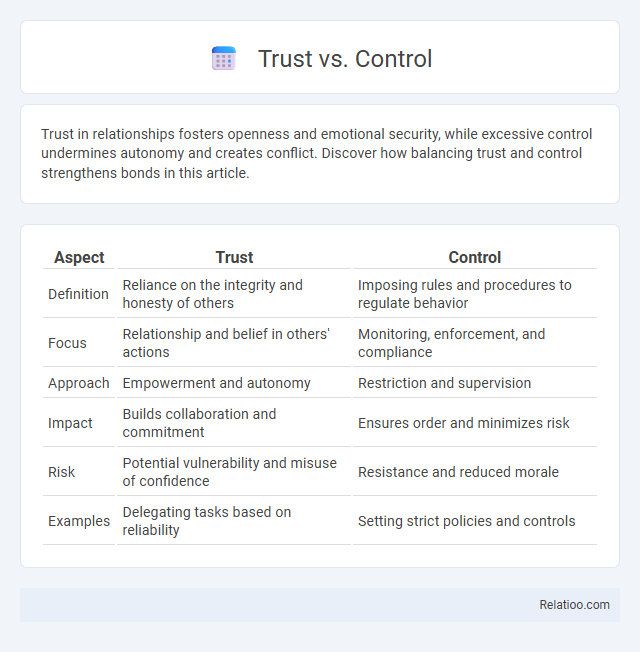Trust in relationships fosters openness and emotional security, while excessive control undermines autonomy and creates conflict. Discover how balancing trust and control strengthens bonds in this article.
Table of Comparison
| Aspect | Trust | Control |
|---|---|---|
| Definition | Reliance on the integrity and honesty of others | Imposing rules and procedures to regulate behavior |
| Focus | Relationship and belief in others' actions | Monitoring, enforcement, and compliance |
| Approach | Empowerment and autonomy | Restriction and supervision |
| Impact | Builds collaboration and commitment | Ensures order and minimizes risk |
| Risk | Potential vulnerability and misuse of confidence | Resistance and reduced morale |
| Examples | Delegating tasks based on reliability | Setting strict policies and controls |
Understanding Trust and Control
Understanding trust involves recognizing its foundation in reliability, honesty, and consistent behavior, which fosters mutual respect and cooperation. Control often emerges as a response to uncertainty, aiming to manage outcomes but can undermine trust when applied excessively or rigidly. Establishing clear boundaries ensures a healthy balance, allowing trust to grow while maintaining necessary oversight to prevent overreach.
The Psychology Behind Trust
Trust forms the foundation of healthy relationships by fostering psychological safety and emotional connection, essential for cooperation and mutual understanding. Your ability to balance trust with control and boundaries shapes how secure and respected you feel, impacting stress levels and overall well-being. Understanding the psychology behind trust reveals that consistency, transparency, and vulnerability are key factors in building and maintaining it effectively.
Why People Crave Control
People crave control as a fundamental need to reduce uncertainty and increase predictability in their environment. When individuals feel in control, their sense of security and competence strengthens, allowing them to navigate challenges more effectively. Establishing healthy boundaries with trust fosters a balanced dynamic where Your autonomy is respected without overwhelming the need for control.
Trust vs Control in Relationships
Trust in relationships fosters emotional security and open communication, enabling partners to feel valued and understood without constant oversight. Control often undermines trust by creating power imbalances and generating feelings of resentment or anxiety, which can erode the foundation of a healthy connection. Establishing clear boundaries supports trust by respecting individual autonomy while preventing controlling behaviors that damage relational harmony.
Workplace Dynamics: Balancing Trust and Control
Balancing trust and control in workplace dynamics enhances team productivity and morale by fostering an environment where employees feel empowered yet guided. Establishing clear boundaries ensures that your team understands expectations while maintaining autonomy, reducing micromanagement and promoting accountability. Effective leadership relies on navigating this balance to build a culture of mutual respect and consistent performance.
The Impact of Control on Team Performance
Excessive control in a team can stifle creativity and reduce motivation, leading to decreased overall performance and innovation. Establishing clear boundaries while fostering trust allows team members to take ownership and collaborate effectively, enhancing productivity and morale. Your leadership approach should balance control and autonomy to create an environment where individuals feel empowered yet aligned with organizational goals.
Building a Culture of Trust
Creating a culture of trust requires balancing trust, control, and boundaries by establishing clear expectations and transparent communication. Implementing consistent policies and empowering employees with autonomy fosters accountability while maintaining necessary oversight. Emphasizing mutual respect and psychological safety encourages collaboration and strengthens organizational loyalty.
Signs of Over-Control and Its Consequences
Excessive control manifests through constant monitoring, lack of flexibility, and suppression of independent decisions, which can erode trust and damage relationships. Your efforts to micromanage behaviors or choices often lead to resentment, reduced motivation, and emotional withdrawal. Recognizing these signs early helps prevent long-term consequences such as diminished self-esteem and strained communication.
Strategies to Foster Trust Over Control
Fostering trust over control requires consistent transparency, open communication, and empowering Your team with autonomy to make decisions. Establishing clear boundaries ensures expectations are understood without micromanagement, promoting a culture of mutual respect and accountability. Implementing regular feedback loops and demonstrating reliability strengthens the foundation of trust in any relationship or organization.
Finding the Right Balance: Trust and Control
Finding the right balance between trust and control is essential for fostering healthy relationships and effective leadership. Too much control can stifle creativity and reduce morale, while insufficient control may lead to chaos and lack of accountability. Your ability to set clear boundaries while encouraging trust creates an environment where individuals feel empowered and responsible.

Infographic: Trust vs Control
 relatioo.com
relatioo.com